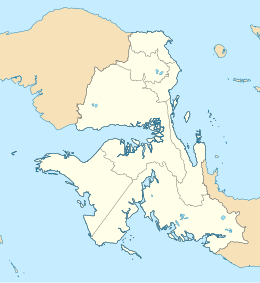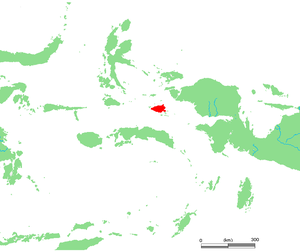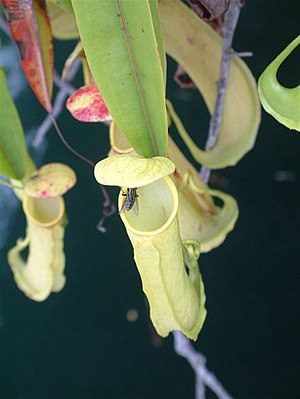Misool
| Geography | |
|---|---|
| Location | Oceania |
| Coordinates | 1°53′41″S 130°5′1″E / 1.89472°S 130.08361°ECoordinates: 1°53′41″S 130°5′1″E / 1.89472°S 130.08361°E |
| Archipelago | Raja Ampat Islands |
| Area | 2,034 km2 (785 sq mi) |
| Area rank | 205 |
| Highest elevation | 561 m (1841 ft) |
| Administration | |
| Province | |
Misool, formerly spelled Mysol (Dutch: Misoöl) or Misol,[1] is one of the four major islands in the Raja Ampat Islands in West Papua, Indonesia. Its area is 2,034 km2. The highest point is 561 m[2] and the main towns are Waigama, located on the island's northern coast, and Lilinta.
The inhabitants speak the Biga language and the Matbat language, as well as Indonesian.[3][4]
Other main islands of this group off the western end of West Papua are Salawati, Batanta and Waigeo, and there are numerous smaller islands such as Kofiau.[5]
Ecology
Terrestrial
Misool is part of the Vogelkop–Aru lowland rain forests ecoregion, which includes the other Raja Ampat Islands and the Bird's Head Peninsula on mainland New Guinea. Plant communities include alluvial, or lowland alluvial rain forest and lowland hill rain forest. Native animals include marsupials, murid rodents, bats, and many birds, including several endemic species.[6] Some native animals include:
- Echymipera kalubu, Common Spiny Bandicoot
- Echymipera rufescens
- Dorcopsis muelleri
- Phalanger orientalis
- Spilocuscus maculatus
- Petaurus breviceps
- Macroglossus minimus
- Nyctimene aello
- Pteropus conspicillatus
- Aselliscus tricuspidatus
- Pipistrellus papuanus
- Lesser bird-of-paradise (Paradisaea minor)
Marine
Misool and the Raja Ampat Islands are part of the Coral Triangle, and islands' coral reefs and coastal waters are some of the most biodiverse on Earth. Native fish include the Misool rainbowfish (Melanotaenia misoolensis) and Misool yellowfin rainbowfish (Melanotaenia flavipinnis).[7][8] A section of Raja Ampat Marine Recreation Park covers the coastal waters southeast of the island. The park was designated in 2009.[9]
History
Islam first arrived in the Raja Ampat archipelago in the 15th century due to political and economic contacts with the Bacan Sultanate.[10] During the 16th and 17th centuries, the Sultante of Tidore had close economic ties with the island.[10][11] During this period, Islam became firmly established and local chiefs had begun adopting Islam.[11]
Misool was a part of the Dutch colonial empire under the Netherlands East Indies administration. The Japanese occupied the island in 1942, became the base of Imperial Japanese Navy until 1945.[12]
Pulau Misool Nature Reserve
| Pulau Misool Nature Reserve | |
|---|---|
| Cagar Alam Pulau Misool | |
| Area | 84,000 ha (320 sq mi) |
| Designated | 1982 |
| Operator | Balai KSDA Maluku |
Pulau Misool Nature Reserve was established in 1982. It covers the southern portion of the island, with an area of 840 km2.[13]
References
- ^ Google Books search for Misol Indonesia
- ^ ISLAND DIRECTORY. UN SYSTEM-WIDE EARTHWATCH Web Site.
- ^ Ethnologue - Biga
- ^ Ethnologue - Matbat
- ^ "Traditional kingdoms of Maluku, early 15th century, and the spheres of influence of Ternate and Tidore, early 16th century". Archived from the original on 2011-07-21. Retrieved 2011-02-10.
- ^ "Vogelkop-Aru lowland rain forests". Terrestrial Ecoregions. World Wildlife Fund.
- ^ Allen, G.R., Hadiaty, R.K. & Unmack, P.J. (2014): Melanotaenia flavipinnis, a new species of Rainbowfish (Melanotaeniidae) from Misool Island, West Papua Province, Indonesia, aqua, International Journal of Ichthyology, 20 (1): 35-52.
- ^ Allen, G. 1996. Melanotaenia misoolensis. 2006 IUCN Red List of Threatened Species. Downloaded on 4 August 2007.
- ^ = "KKPD KABUPATEN KEPULAUAN RAJA AMPAT". Protected Planet. Accessed 8 August 2021. [1]
- ^ a b Wanggai, Toni V. M. (2008). Rekonstruki sejarah umat Islam di tanna Papua [Reconstruction of the History of lslam in Papua]. Syariff Hidayatullah State Islamic University Jakarta (in Indonesian). Retrieved 2022-03-13.
- ^ a b Slama, Martin (2015), "Papua as an Islamic Frontier: Preaching in 'the Jungle' and the Multiplicity of Spatio-Temporal Hierarchisations", From 'Stone-Age' to 'Real-Time': Exploring Papuan Temporalities, Mobilities and Religiosities, ANU Press, pp. 243–270, ISBN 978-1-925022-43-8
- ^ No. 92 of the Japanese Monographs — "Southwest Area Naval Operations, Apr. 1942 – Apr. 1944", 10 September 1947.
- ^ a b "Pulau Misool". Protected Planet. Accessed 8 August 2021. [2]
External links
 Media related to Misool at Wikimedia Commons
Media related to Misool at Wikimedia Commons- Jelle Miedema, Perspectives on the Bird's Head of Irian Jaya, Indonesia: Proceedings of the Conference Leiden, 13–17 October 1997
- Indonesia Field Project - Misool - Marine Conservation Agreements


